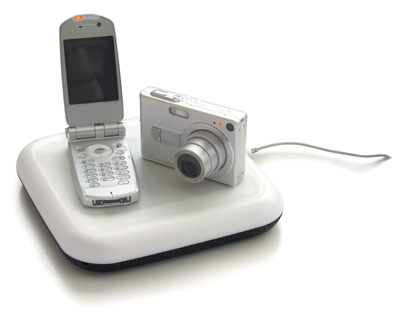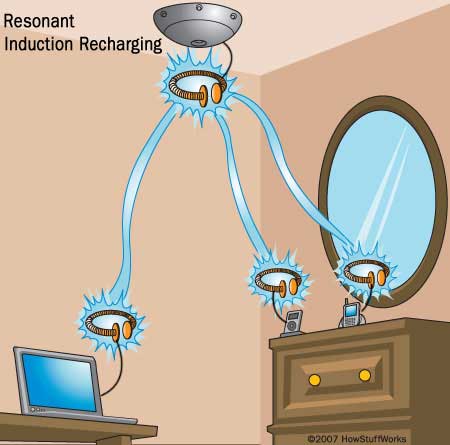Wireless Electricity
THE IDEA 
Today, portable technology is a part of every day life. Having your stereo, telephone or computer tied to a wall is a thing of the past. But from portability emerges another challenge: energy. Almost all portable devices are battery powered, meaning that eventually, they all must be recharged–tying the user back to the wall he was trying to avoid.
Now imagine that instead of plugging in your cell phone, laptop or mp3 player to recharge it, it could receive its power wirelessly–quite literally, “out of thin air”. Sound like science fiction? It’s much closer to reality than you might think.

Wireless electricity could make this phenomenon a reality.
HOW IT WORKS 
Wireless energy transfer (WET) is the process where electrical energy is transmitted from a power source to an electrical load, without interconnecting wires. There are two main methods of wireless electricity transmission, mutual induction and evanescent wave coupling.
Mutual induction is the production of voltage across a conductor situated in a changing magnetic field or a conductor moving through a stationary magnetic field. This allows for the wireless transmission of electricity over a very close proximity and is already in use in items such as electric toothbrushes and convection ovens.

The “Splashpad”, a brand of wireless charging pads based on mutual induction technology.
This technology has currently expanded and is being marketed by a number of companies who have created “charging pads”—areas on which electronic devices can simply be placed and receive a charge. However, while this is effective for powering devices such as cell phones or laptops, this method of wireless electricity requires too close a proximity for any sort of medium- to long-range power transmission. Another means of wireless energy transfer, Evanescent Wave Coupling, hopes to change that.
Evanescent Wave Coupling (EWC), or non-radiative energy transfer, introduces a concept called “resonance” to the wireless energy equation. Similar to mutual induction, wherein electricity traveling along an electromagnetic wave moves between coils on the same frequency, EWC functions on the concept that if you make both coils resonate at the same frequency, electricity can be passed between them at farther distances and without health dangers. According to this theory, one can even send electricity to multiple devices at once, as long as they all share the same resonance frequency. While this technology is yet to come to market, in 2007, researchers at MIT published a detailed report describing a working prototype they had built which powered a light bulb from two metres away.

A depiction of how Evanescent Wave Coupling would work.
ITS ROLE IN ORGANIZATIONS: THE PROS 
The potential of wireless energy transfer for organizations is limitless. Firstly, mutual induction would allow for a significant decluttering of office space and reduction of e-waste by eliminating the need for power cords. With this technlogy, all desks could be equipped with “power-pads”, where devices could sit and receive electricity without the use of wires.
Moreover, as EWC technology advances, it could provide an even greater convenience—the removal of all power lines throughout buildings. With one or two EWC transmitters, companies could power any electronic device from anywhere in the office. For example, one could add extra lighting to an office without having to hire an electrician, as the light bulb would receive its electricity wirelessly.
ITS ROLE IN ORGANIZATIONS: THE CONS 
The main downside of wireless energy transfer for organizations is the need for standardization and adaptation. If WET were to be implemented, any pre-WET technology would have to be adapted or risk becoming obsolete. For mutual induction pads, which are already in use in some organizations, a device must either be pre-built with wireless charging capabilities or have an adapter attached to be able to be charged wirelessly (EWC would require a similar adaptation process). Retrofitting old equipment or purchasing new equipment could become a very expensive endeavor, even for such a high level of convenience. Any modern organization, which would have many computers and peripheral devices, may be hesitant to adapt to a technology with such a heavy price tag.
Another downside would be the possibility of “energy theft”. Since electricity transferred using EWC technology relies only on two or more devices having the same frequency resonation, and since EWC technology can power many devices at a time, as soon as the resonance frequency is identified, an individual in close enough proximity (a neighbour, for example) could steal another’s electricity without leaving his home.
THE FINAL WORD 
Overall, wireless electricity seems like a novel concept that is already demonstrating some organization application. While it faces a number of difficult challenges before it reaches large-scale adoption, it offers a convenience great enough to motivate many people to make the change.
Sources:
Biever, Celeste. “‘Evanescent coupling’ could power gadgets
wirelessly.” New Scientist Tech 15 Nov. 2006. 29 Sep. 2007
Available at: <http://technology.newscientist.com/article/dn10575-evanescent-coupling-could-power-gadgets-wirelessly.html>.
“Goodbye wires… MIT experimentally demonstrates wireless power
transfer.” PHYSORG.com 7 June 2007. 29 Sep. 2007
Available at: <http://http://www.physorg.com/news100445957.html>.
Wilson, Tracy V. “How Wireless Power Works.” Howstuffworks 29
Sep. 2007
Available at: <http://electronics.howstuffworks.com/wireless-power1.htm>.
Murph, Darren. “Powercast looking to bring wireless power to reality.”
Engadget 30 Mar. 2007. 30 Sep. 2007
Available at: <http://www.engadget.com/2007/03/30/powercast-looking-to-bring-wireless-power-to-reality/>.
Castelvecchi, Davide. “Wireless energy could power consumer, industrial
electronics.” Massachusetts Institute of Technology: News Office 14 Nov. 2006. 29 Sep. 2007
Available at: <http://web.mit.edu/newsoffice/2006/wireless.html>.
Johnson, R. C. “Practical apps in works for wireless energy transfer.”
EETimes.com 22 Jan. 2007. 29 Sep. 2007
Available at: <http://www.eetimes.com/showArticle.jhtml?articleID=196901215>.
Yomogita, Hiroki. “[CEATEC Preview] Murata, Seiko Epson to Jointly
Develop Non-contact Quick Charger.” TechOn! 28 Sep. 2007. 29 Sep. 2007
Available at: <http://techon.nikkeibp.co.jp/english/NEWS_EN/20070928/139876/>.
Filed under: MGCR 331 | 18 Comments
Tags: electricity, emerging technology, energy transfer, WET, wireless
Here is a good site explaing how it works.
http://www.powercasttechnology.com
Here is a cool webist on this technology works.
http://powercasttechnology.com
I am doing post graguation in power system.i am vety much interested in wireless electricity.any article or new invension related to this please mail me
i want more knowedge related to this.
help me
evede nadakkan>>>>>>>>>>>>>>>>>>>>>>>>>.
I can’t wait until I can get me some of that wireless electric in my house. They need to invest more in getting it to us quicker!!
any development in this field or any better information than this please mail me.
any development in this field or any better information than this please mail me or inform me
hiiiiiiiiii
I m BE (e&tc) student from nasik .I make project on wireless power transmission . so please help me .
extra details for wireless transmission of electric power
the idea is really awsome but i just want 2 know how it work’s if posible can any one tell me
Are you aware that this concept is noting new in fact a man by the name of Nikola Tesla not only had the same idea but on a grander scale! Wireless electricity on a globe scale and you only need to receive it to use it. http://en.wikipedia.org/wiki/Wardenclyffe_Tower
Yes I’m intrested to know that how it works ………even can energy be transffered without using transmission line to their destination…..
i need information regarding this…plz help me…….
Has anyone thought about that this technology may be dangerous around gas appliances? they always say never switched the electricity on or off but what happens if you just walk in with that cell phone!
I need to know the power losses in the system and the efficiency transmitted ver. received power.
What is the frequency that the system runs at?
What is the EMF values of all radiated power?
At what distances does this system work with at least one kilowatt being consumed?
Keep it up, bookmarked and referred some friends.
light bulbs are good for lighting the home but stay away from incandescent lamps because they generate so much heat :”`